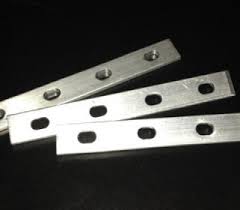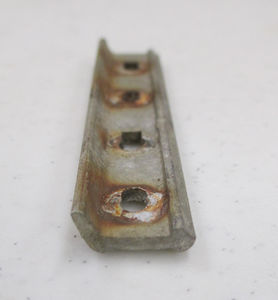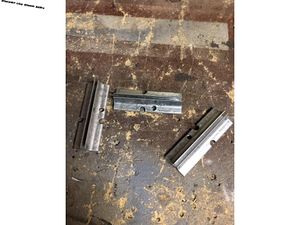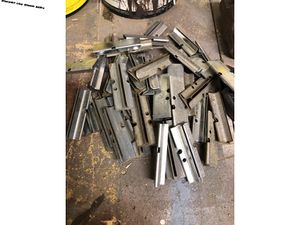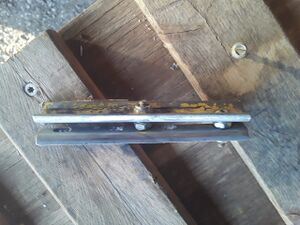Rail joiner: Difference between revisions
Jump to navigation
Jump to search
(→Spall) |
|||
| Line 19: | Line 19: | ||
File:Slip on rail joiners west coast rail 2.jpg | File:Slip on rail joiners west coast rail 2.jpg | ||
File:Slip on rail joiners west coast rail 1.jpg | File:Slip on rail joiners west coast rail 1.jpg | ||
</gallery> | |||
== Drill Gauge == | |||
A simple drill gauge can be made with standard rail joiners as shown in the photos below. Use a felt tip pen to mark the holes on the web of the rail to be drilled. Never drill the holes with the gauge in place, as it will tend to enlarge the gauge's holes over time. The idea comes from Texas railroad builder Ken Smith. Ken suggested to drill the hole in three steps: 1/8 inch, 7/32 inch, and finally 5/16 inch. The hole is oversized to allow [[Rail expansion|expansion and contraction]] of rail. | |||
<gallery widths="300px" heights="300px" perrow="2"> | |||
File:KenSmith RailJoinerGauge 2020-12-15 16.29.12.jpg|A simple rail joiner gauge can be made by drilling a hole in the center of two rail joiners, then attaching them together with screws, washers and nuts. | |||
File:KenSmith RailJoinerGauge 2020-12-15 16.29.10.jpg|A close of this rail joiner gauge shows that the center is spread slightly more than the tail by adding a washer on either side of the center nut. This allows the gauge to slide easily onto the end of the rail to be marked. | |||
</gallery> | </gallery> | ||
Revision as of 15:00, 17 December 2020
Side screw
Drawings for rail joiners used on Mill Creek Central Railroad.
Spall Slip Joiner
From Train Mountain Encyclopedia, v 4-13 (PDF):
- Ed Spall, a member first of the Los Angeles Live Steamers, and subsequently of the Sacramento Valley Live Steamers, developed an alternative method for joining track in the early 1990's.The Spall Rail Joiner is essentially a scaled up HO track joiner that is four inches long and slips around the foot and up the web of the rail. Train Mountain has done the tool and die work to produce these joiners in quantity. They have been in use since 1992 as a part of the Train Mountain Track System and on tracks all over the country, with excellent results.
Drill Gauge
A simple drill gauge can be made with standard rail joiners as shown in the photos below. Use a felt tip pen to mark the holes on the web of the rail to be drilled. Never drill the holes with the gauge in place, as it will tend to enlarge the gauge's holes over time. The idea comes from Texas railroad builder Ken Smith. Ken suggested to drill the hole in three steps: 1/8 inch, 7/32 inch, and finally 5/16 inch. The hole is oversized to allow expansion and contraction of rail.
